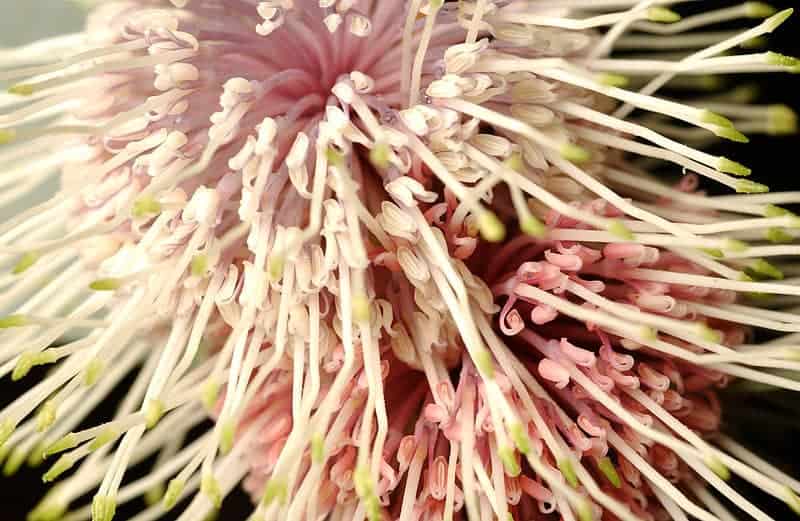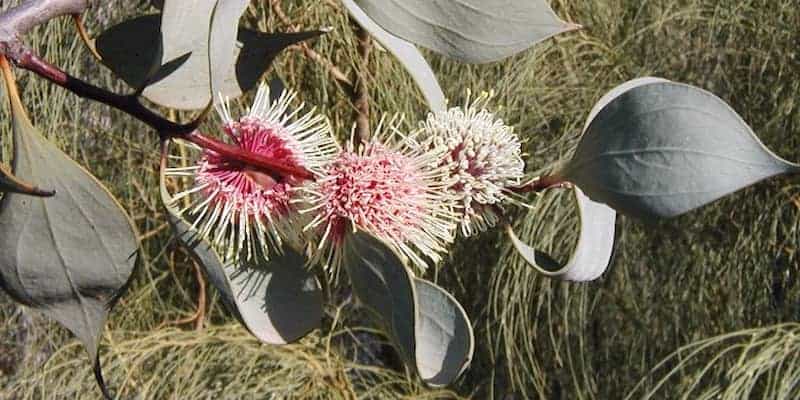If you’re after sugar, spice and everything nice for your garden, the Hakea Petiolaris is worth giving a chance.
There are many words to describe this Australian flowering plant — and ordinary isn’t one of them!
Continue reading to learn why the Sea Urchin Hakea is the plant you need to spruce up your outdoor space.
Sea Urchin Hakea description

So what makes the Sea Urchin Hakea special? For one, they’re a great outdoor plant to have when you need a little pick-me-up during winter. The frost resistant Sea Urchin Hakeas flower well during this time of the year and into spring.
No sullen-looking branches for you when the Sea Urchin Hakea is around, only prolific buds that attract plenty of nectar-eating birds, bees, and butterflies.
Since it does well in large, sunny spaces, the Sea Urchin Hakea is a popular choice as a street tree.
You can also use it as a feature plant in your garden, then harvest the blossoms afterward for a one-of-a-kind cut flower arrangement.
When it comes to size, bigger is definitely better! The Hakea Petiolaris can be classified anywhere between a large shrub to a small tree.
It measures up to 9 metres in height and 4 metres in width when fully mature. You can find plenty of Sea Urchin Hakeas in the Jarrah Forest of Western Australia.
It’s easy-care nature makes it one of the most common subspecies of the Hakea around.
Like other native Australian shrubs and flowering plants, it prefers well-drained soil and low humidity.
If you’re a busy plant lover who dreads carving time out for the next watering schedule, this plant is the perfect choice for you.
There’s no such thing as too little TLC for this plant — smothering it with frequent watering will only cause your Sea Urchin Hakea to have root rot.
You will also love this plant for its tendency to tolerate a wide temperature range: it thrives in warm temperate regions, and is also fairly frost resistant.
How to care for a Hakea Petiolaris plant

When it comes to plant care, you won’t have any trouble growing or maintaining the Sea Urchin Hakea. It needs very little attention, as far as low-maintenance plants are concerned.
Just like the lovely Hakea Laurina, the striking Sea Urchin Hakea is a beach lover, which means it grows best under sunny skies and thrives when planted in sandy soil.
Little moisture — and human intervention apart from regular pruning — is needed to keep it healthy.
Pick a sunny position
Your Hakea Petiolaris loves plenty of sunlight.
Plant it in a sunny spot in your garden to encourage it to grow into the erect shrub it’s meant to be.
Plant it in well-drained soil
Hakeas prefer dry, well-drained soil that’s similar to the soil composition in a coastal environment.
The soil pH should be slightly acidic to neutral to ensure the best health for your shrub.
Some suitable soil types to use as planting mix for your Hakea are sandy loam and clay loam.
Water sparingly
Because it is prone to root rot, the Sea Urchin Hakea should be watered sparingly.
Don’t worry that it will get dehydrated — like other Hakea varieties, the Hakea Petiolaris is drought tolerant and hardy against a wide range of environmental conditions.
It detests getting waterlogged, as this can encourage fungal and bacterial growth in the roots of the plant.
Prune while young
While it is still growing, trim your Hakea a few centimetres back from its tips to maintain a bushy look.
After the flowering season, give your Hakea a light pruning — trimming off 10-20cm all over — to manage its shape and size.
Refrain from cutting back thick branches, however, as they may not grow back once cut.
Hakeas are fast-growing shrubs and will benefit well from a regular prune.
If the size of your plant is a little overwhelming for you — or you just can’t find time in your schedule for pruning — getting professional pruning services is a great solution for you.
Flowering season for the Sea Urchin Hakea

Hakeas are known to have unique-looking flowers that add interest to any outdoor space. The Hakea Petiolaris is no different from other Hakea varieties when it comes to flowers that come with a wow factor.
With spiny globular buds clustered in groups, Hakea Petiolaris flowers look like a cross between sea urchins and dandelions.
Watching these plants during the course of their flowering — which happens in late autumn or early winter — is quite entertaining, as well.
As the Sea Urchin Hakea flower matures, the perianth changes from cream to pinkish mauve and then maroon in colour.
At the end of the flowering process, the clusters of hairy-looking tennis balls transform into curious-looking bunches of brown, woody pods.
Common Hakea Petiolaris pests and diseases
As with some Western Australian plants, too much humidity causes fungal infections like botrytis and root rot.
If left undiagnosed, root rot can cause your plant to die within a week once infected.
Symptoms to watch out for are leaf drop or leaf wilting, or a change in leaf colour.
If your plant is showing signs of poor health or stunted growth, it’s best to consult with a gardening professional in your area for proper treatment.
Propagating a Hakea Petiolaris plant
The Hakea Petiolaris is best propagated from seed. To begin, harvest the pods using sharp secateurs and extract the seeds from the pods.
Plant the seeds in a planting container with a well-draining soil mixture. Moisten regularly until the seeds germinate.
Once the roots have formed, you can transfer them to a bigger planting site to establish.

